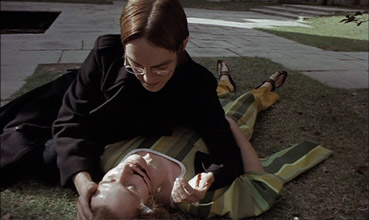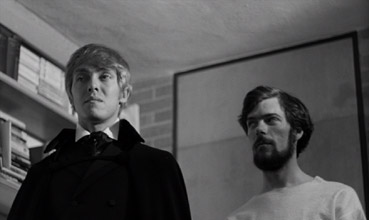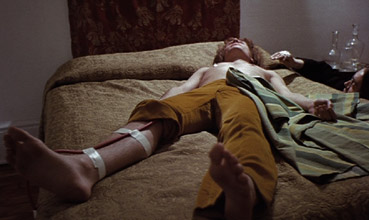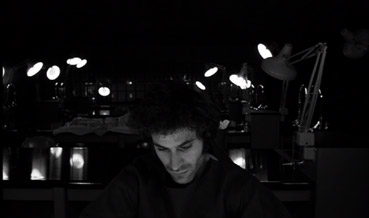|
If
the titles Stereo and Crimes of
the Future ring no bells with you then you are
no true devotee of the cinema of David Cronenberg. At just over an hour each,
they can be viewed as either his first two feature films
or extensions of the short film format he had already worked
with in Transfer and From the Drain.
Stylistically, they are both examples of intellectual experimental
cinema, meditations on the director's own theoretical musings
on human communication, biology, behaviour and sexuality.
If you're looking for early examples of Cronenberg's body
horror then you're largely out of luck. Indeed, if you come
to either of these films expecting an entertainment, even
in the unique manner that Cronenberg has fashioned
over the years, you're likely to be severely disappointed.
Despite some telling thematic touchstones, the films have
more in common with the work of William Burroughs, Anthony
Balch and Chris Marker than the twisted takes on exploitation
cinema that were soon to define Cronenberg's early film career.

And
yet both films are, in their way, distinctively Cronenberg
pieces, most notably in the density of their behavioural
and scientific theorising, and their striking use of faceless
institutional locations. Neither of them are narrative works
in the traditional sense, having the detached sterility
of information of educational films made by a government
department interested only in evidence and hard facts. Emotional
responses are discussed and to a degree observed, but never
expressed. This is the sort of art school film-making that
will instantly alienate a sizeable proportion of its potential
audience, even those who count themselves as fans of the
director's later work, but just as many will take its anti-narrative
and avant-garde elements dearly to heart.
Back in the 1980s, you could often find the two films playing
together in London independent cinemas, and at the very
same time Cronenberg himself was suggesting in interview
that they would prove pretty heavy going as a double bill.
To a degree he's right, but given that both are cinema as
art and intellectual discourse, they demand to be read
in a different manner to works whose
prime purpose is to entertain. Whether you'll want to do
so, or whether you'll be at all receptive to Cronenberg's
very singular approach, is another matter entirely.
At
the Canadian Academy for Erotic Enquiry, a number of volunteer
telepaths are observed and studied by the staff. The procedures
used and the conclusions reached are relayed in voice-over
by a number of the researchers, as the volunteers go about
their daily lives, interact with each other, and participate
in the experiments being described.
Although
a narrative is hinted at early on with the arrival of a
black-dressed character (Ronald Mlodzik, a close ringer
for a young Peter Cook) who could be either scientist or
participant, the on-screen action is largely observational
and often unrelated to surrounding scenes, at least in narrative
terms. The film itself is devoid of sound effects and music,
the silence broken intermittently by voices that explain
the work of the Academy and its findings in such coldly
analytical terms that it's all too easy to hear the voice
but not take in the words. But it is here that the film is most
recognisably a Cronenberg piece, the dispassionate meditations
on the telepathic abilities of the subjects under investigation
proving consistently intriguing, particularly the concept
of telepathic addiction and the suggestion that telepathic ability is governed
in part by the level of attraction between telepath and
subject. This itself leads to some interesting postulations
on the politics of sexuality, the suggestion being that heterosexuality
and homosexuality are equally perverse and the only
true norm is bisexuality.

The
film is sometimes visually arresting, the large modernist
clinic with its long corridors and featureless walls acting
almost as an expressionistic extension of the emotionless
narration, and inevitably foreshadowing the use of similar
institutional constructs in Rabid and The
Brood. The most obvious signal of things to come,
however, is in the discussion of telepathy, some of which
would find its way into Scanners, specifically
the idea that drilling a hole in the forehead might alleviate
the pressure caused by the thoughts of others.
The
difficulty here is that much of the on-screen action is
a tad too non-specific, casual interactions between characters
that are often divorced from the information being delivered
in the narration. Although this itself is not an issue, at
63 minutes in length it can occasionally prove tough going,
as minutes tick by with little to keep the eyes busy and
nothing at all for the ears. As an experiment, it is fascinating
and sometimes intellectually arresting, but for many the
length will prove self defeating, as there is little variance
in the style and no development of story or, to any significant
degree, character. But it IS intriguing, specifically for
its often complex and well devised theoretical musings,
its pointers to the director's later cinematic obsessions,
and for its visual panache. That it was shot by Cronenberg
himself suggests that had he not chosen to direct, he could
have carved a successful career as a
cameraman.
Despite
boasting more in the way of story and being shot in colour
rather than black-and-white, Crimes of the Future could in many ways be viewed as being the second part of
the cinematic experiment begun by Stereo. Visually, there are immediate
and obvious similarities, notably in the concrete modernist
institutes in which both films are set, and the black-dressed
lead character (again played by Ronald Mlodzik), and once
again this is essentially a silent film driven by voice-over.
This time around, however, it is spoken in the first person
and the soundtrack is peppered with semi-abstract sound
effects, recordings of water and sea creatures used by Cronenberg
to create the sense of, in his own words, "an underwater
ballet."

The
lead character, and the man whose musings guide us through
the film, is the splendidly named Adrian Tripod (the slightly offbeat pronunciation
of which is difficult to explain in print), a doctor at
a clinic known as The House of Skin, which since the death
of "the mad dermatologist" Anton Rouge has fallen
into serious decline. Only one patient remains, and control
of the clinic has effectively fallen to Tripod's two sullen
interns, whose purpose he is unsure of. When the last patient
dies of a condition known as Rouge's Malady, Tripod transfers
to The Institute for Neo-Venereal Disease and develops a
technique for treating patients by telepathically connecting
with them through their feet.
I
mean, look at that plot. Pure Cronenberg. But as played out
here, driven as it is by an emotionless narration and with
no live sound or dialogue, it's not quite as thrilling
as it sounds. The avant-garde minimalism of Stereo
is also at the core of Crimes of the Future,
and despite the addition of some plot development, this is likely
to alienate almost as many hopeful viewers as its predecessor.
But it also shares all of that film's strengths, from its
intellectual scientific theorising to its cinematic fluidity,
and also has its share of pointers to the director's future
work, most memorably the patient who begins growing 'puzzling,
functionless organs', which touches on territory that was
to be more fully explored in The Brood
and Dead Ringers.* This blending of experimental
minimalism and twisted storytelling is ultimately seductive,
and towards the end involves us in a sequence as disturbing
as anything Cronenberg has done since, though interestingly
for what is suggested rather than what is actually shown.
Although
the unsympathetic may claim otherwise, Cronenberg is not
merely flirting with ideas or playing with the camera here,
both films reflecting a very specific vision and demonstrating
an emerging and exciting cinematic style. That's not to
say they are going to work for everyone, and they are as
likely to annoy and exasperate as they are to enthrall or
excite. Both require patience, tolerance, and a willingness
to go beyond the confines of narrative cinema, but if you're
up for it, then the rewards are most definitely there.
Despite
knowing that both films were shot on 35mm, their status
as low budget, little seen early works created in me unfairly
low expectations for the transfer quality. Well Reel 23
certainly showed me. Despite some print damage (most noticeable
on Crimes) that has been very effectively
toned down, the transfer quality of both films is very impressive,
boasting a very good level of detail and sharpness, impressive
contrast and solid black levels. The colour on Crimes
is faithfully reproduced, and vivid on the rare
occasions when bright colours are used. There is some occasional
frame instability on Crimes – it doesn't
last long when it happens, but you can't exactly miss it.
The framing is 1.66:1 and is anamorphically enhanced.

Both
films feature Dolby mono soundtracks and there's not a lot
to say about them, especially given that Stereo
is silent for a good portion of its running time. The narration is clear enough, but both show their age and their low budget origins
more obviously than the picture.
None on the disc itself, but the sleeve notes fold out to
a poster and include a director's statement on both films,
which is very interesting, plus an overview of Cronenberg's
career.
Previously
only available as extra features on disc 2 of Blue Underground's
US release of Fast Company,** the release
on UK DVD of these two early experiments by one of modern
cinema's genuine masters is to be warmly welcomed, especially
given the quality of the transfers, which are considerably
better than I was expecting. They are definitely not for
everyone, but are a must-own for Cronenberg devotees, even
though a fair proportion will doubtless end up wondering
what the hell big Dave thought he was up to. I've always
had a soft spot for both films, and coming to them again
on DVD after several years I've developed a real affection
for them. And in an age of cinematic anti-intellectualism,
the sheer range and imagination of the ideas under discussion,
however dispassionately or satirically, is a joy in itself.
|